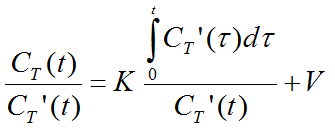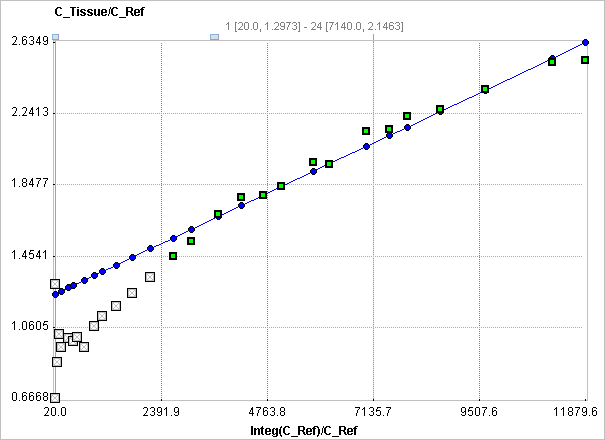The Patlak plot has been developed by Patlak and Blasberg [1] for tracers undergoing irreversible trapping. Most often it is applied for the analysis of FDG, which can be modeled as a 2-tissue compartment model with k4=0.

However, this model structure is not necessary for the application of the method. It is sufficient to have any compartment in the system which binds irreversibly.
When the plasma activity is not available, the Patlak plot can be employed as a reference method provided that there exists some tissue wherein tracer is not irreversibly trapped. The procedure simply replaces the input curve by the reference tissue TAC.
Operational Model Curve
The Patlak plot belongs to a group of Graphical Analysis techniques, whereby the measured tissue TAC CT(T) undergoes a mathematical transformation and is plotted against some sort of "normalized time". The Patlak plot using reference tissue is given by the expression

with the reference tissue TAC CT'(t). This means that the measured PET activity is divided by the reference tissue activity, and plotted at a "normalized time" (integral of the reference TAC from the injection time divided by the instantaneous reference activity). For systems with irreversible compartments this plot will result in a straight line after an equilibration time t*.

Under several assumptions, including a common K1/k2, the slope of the linear regression represents the following relation

with the equilibrium constant Keq.
The reference Patlak plot has been applied for the FDOPA PET tracer for calculating an index of the influx Ki.. Both the cerebellum and the occipital lobe have been used as the reference [2].
Parameter Fitting
The Patlak Reference model calculates and displays the transformed measurements as described by the formula above. It allows fitting a regression line to the data segment starting at time t*. The results are the slope K and the Intercept of the regression line.
t* can be specified manually, or a value estimated using an error criterion Max Err. For instance, if Max Err. is set to 10% and the fit box of t* is checked, the model searches the earliest sample so that the deviation between the regression line and all measurements is less than 10%. Samples earlier than the t* time are disregarded for regression and thus painted in gray. Note that t* must be specified in real acquisition time, although the x-axis units are in "normalized time". The corresponding normalized time which can be looked up in the plot is shown as a non-fitable result parameter Start. In order to apply the analysis to the same data segment in all regions, please switch off the fit box of t*, propagate the model with the Copy to all Regions button, and then activate Fit all regions.
References:
1.Patlak CS, Blasberg RG: Graphical evaluation of blood-to-brain transfer constants from multiple-time uptake data. Generalizations. J Cereb Blood Flow Metab 1985, 5(4):584-590. DOI
2.Sossi V, Holden JE, de la Fuente-Fernandez R, Ruth TJ, Stoessl AJ: Effect of dopamine loss and the metabolite 3-O-methyl-[18F]fluoro-dopa on the relation between the 18F-fluorodopa tissue input uptake rate constant Kocc and the [18F]fluorodopa plasma input uptake rate constant Ki. J Cereb Blood Flow Metab 2003, 23(3):301-309. DOI